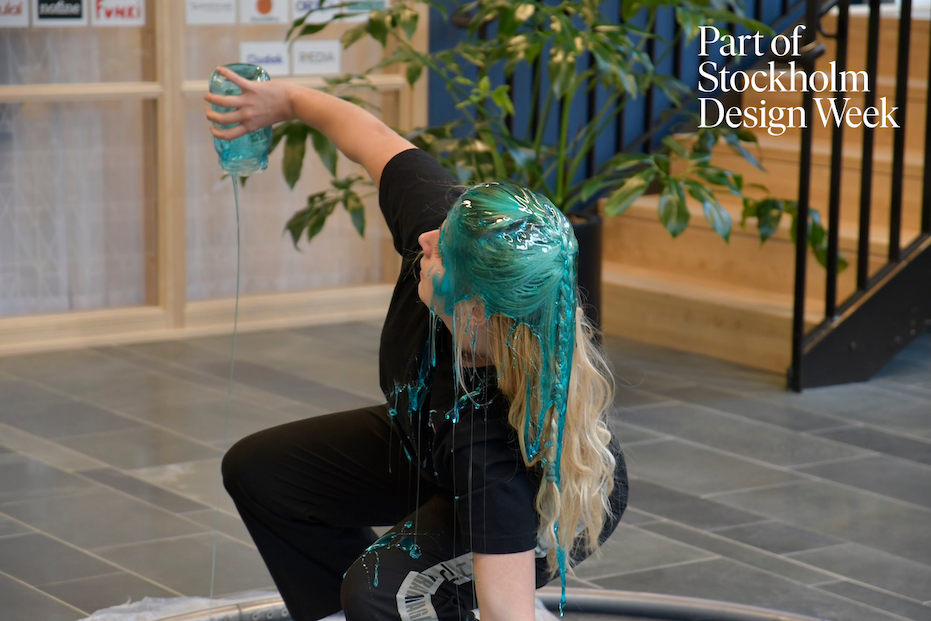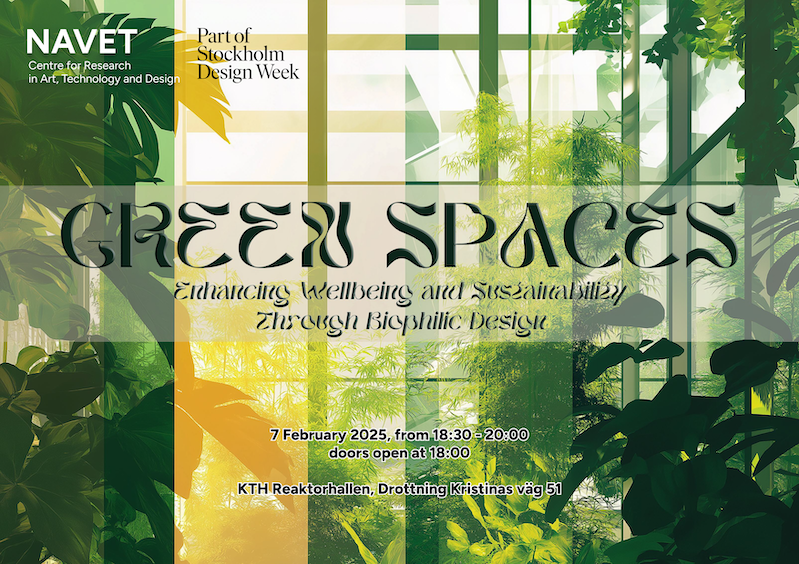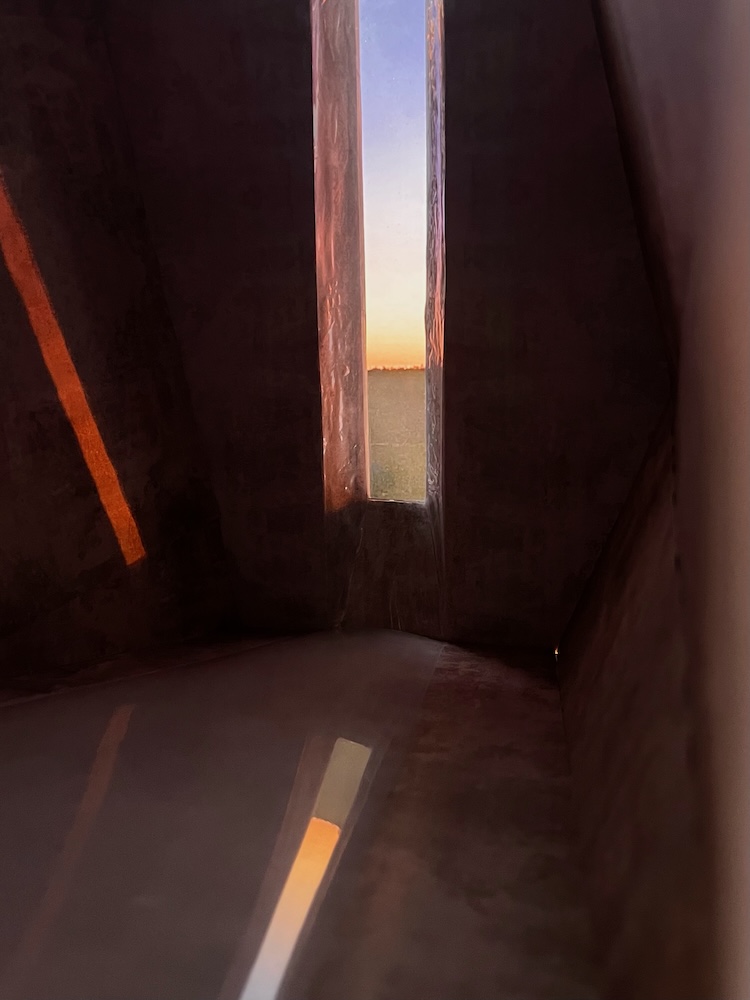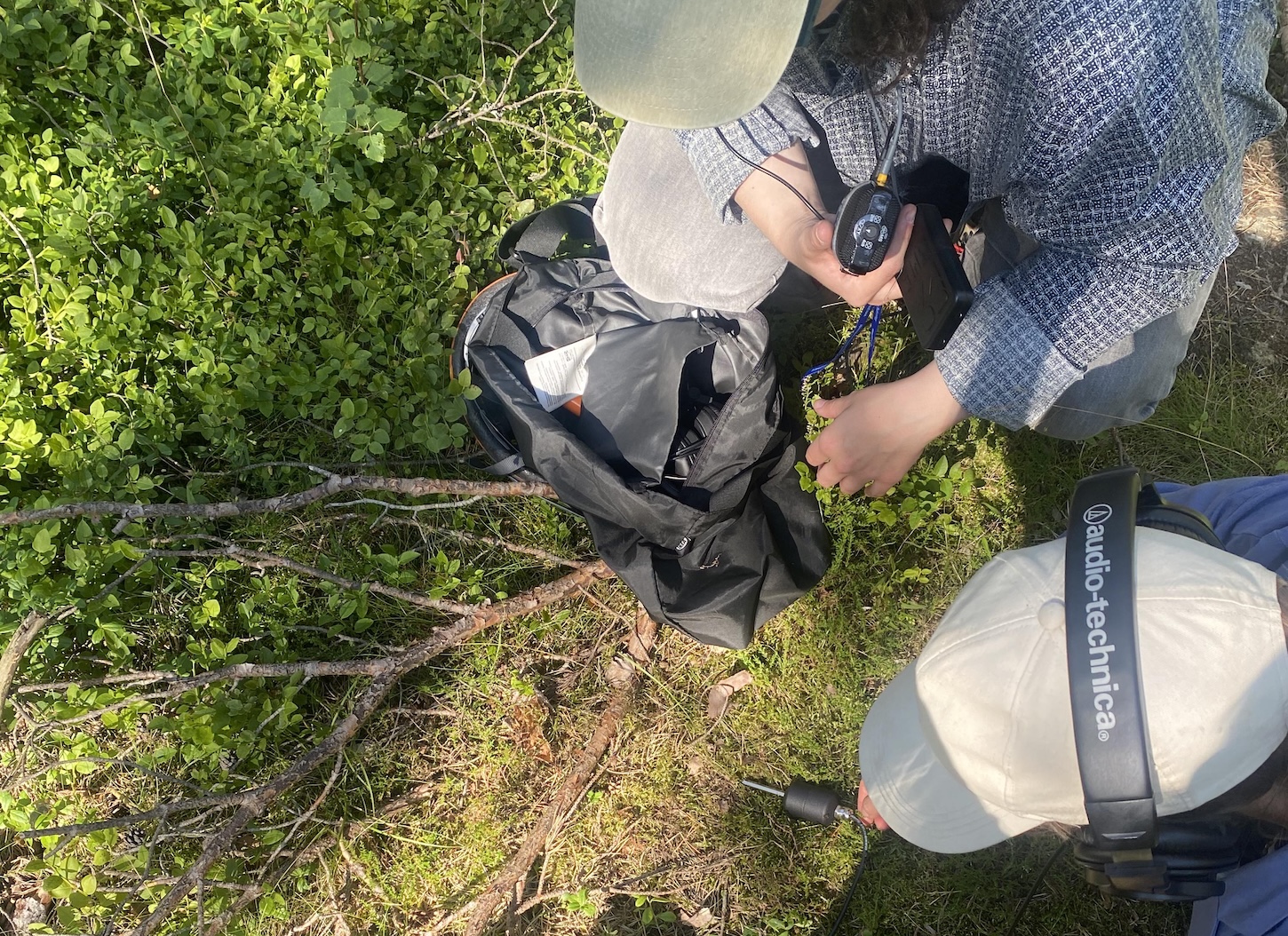NAVET events at the Stockholm Design Week 2025

For the first time, NAVET participates at the Stockholm Design Week with a series of initiatives, including events at the NAVET Open House at the KTH Reactor Hall on Feb 8th and 9th.
This year, NAVET participates at the Stockholm Design Week with an own stand in the Greenhouse at Ävsjömässan , and with the organization of a series of events at KTH Reactor Hall.
Please, scroll down this page to get information about all NAVET events at the Stockholm Design Week 2025 and the programme of the KTH Reactor Hall Open House on Feb 8th and 9th.
February 3-8 Activities at Stockholm Furniture Fair (Stockholmsmässan)
Please visit us at Stand C03:70 in the Greenhouse .
NAVET presentation on February 4 at 15:00 at Greenhouse Small Talks C01:50: KTH NAVET – A hub for navigating unexplored areas between art, technology and design
Display of ongoing projects by the IxD Interaction Design team at KTH

In two cabinets at the NAVET stand, researchers of the IxD Interaction Design team at KTH present the design and build of novel interactions with electronically responsive artifacts and services. Researchers incorporate critical perspectives from feminism, somaesthetics, and sustainability into their design and process.
No Tree is an Island - Interactive installation connecting the Stockholmn Furniture Fair to the KTH R1 Reactor Hall

Communication builds resilience. Explore the vital linkages between trees and fungi within mycorrhizal networks and the pivotal role of old trees through this interactive multimedia installation. What can trees teach us about the connections in the forest as well as our connections to each other? By interacting with and witnessing the communicative mechanisms of mycorrhizal networks, we hope to inspire a reevaluation of how we may build bridges to one another, creating a resilient society.
As the saying goes, no man is an island.
If you visit KTH R1 Reactor Hall on Saturday 8th, you will experience the realtime projection of the graphics resulting from the interaction with our installation at the Stockholm Furniture Fair.
No Tree is an Island is a project realized for the
NAVET Student Festival 2023/2024
by:
Klara Vedin (KTH Royal Institue of Technology): Research and idea development
Karl Simu (KTH Royal Institue of Technology): Computing and electronics
Leo Eltes (KMH Royal College of Music): Sound and visual design
For more information about the project please follow this link: No Tree is an Island
At our stand you can find a video displaying some of the projects realized at NAVET and information about calls for student projects .
February 6-9 Events at KTH Reactor Hall
Location: KTH Reactor Hall
NAVET organizes a series of events at the KTH Reactor Hall during the SDW Stockholm Design Week 2025.
Below here you can find a detailed programme of all events, which you can also find in the official SDW app.
Participation to all events is free, but there is a limit to the number of participants for some of them.
February 6 at 15:00-17:00: Workshop "Learn it your way!"
The workshop is lead by Luigia Brandimarte , recipient of KTH Pedagogical prize 2022 .

This workshop invites participants to explore and reflect on innovative approaches to learning in higher education. We will discuss how different approaches might help reaching out to different learners and will combine: 1) traditional textbook-based learning, 2) experiential learning and 3) innovative learning through the integration of the performing arts. This session aims to inspire new ways of thinking about education, encouraging participants to consider how different learning styles can be combined for a more dynamic and effective educational experience. Whether you're a student, educator, or simply curious, this workshop provides an open space to discuss the future of learning.
When: 6th February 2025, from 15.30 - 17.00. Doors open at 15:00.
Length of the event: approx. 1 h 30 min
Where: KTH Reactor Hall, Drottning Kristinas väg 51
Participants: up to 50, no reservation needed
February 7 at 18:00-20:00: Performance lecture "Green Spaces"

The performance lecture is lead by Christine Nordqvist (KTH Royal Institue of Technology) and Dario Samardzic (SKH Stockholm University of the Arts).
For more information please follow this link:
Green Spaces: Enhancing Wellbeing and Sustainability through Biophilic Design
February 8 and 9, 11:00-15:00: Open house with exhibitions, installations and circus performances
The NAVET Open House at KTH Reactor Hall is an opportunity to experience the variety of student projects at the intersectional area between Art, Technology and Design.
KTH Architecture, Lighting Design Division, presents architectural models of a "Daylight pavilion”. Visit us to get inspiration on how to design for people with daylight.

The daylight pavilions focus on the interplay of daylight, people and environment, delving into perceptual, cultural and environmental aspects. Understanding how to employ and control daylight in space is a fundamental skill in design practice. This knowledge fosters a deeper connection among available sources of light, user and the surrounding context over time. Such understanding and design are achieved, among other methods, through evaluation of daylight conditions, framework conceptualization, analysis of the natural environment, formal exploration, thoughtful arrangement of openings -whether windows, skylights, or other features-, and material studies. These skills not only build upon this connection but also ensure that aesthetic choices serve a purpose, enhance interior illumination, promote health and well-being, and reduce reliance on artificial lighting, thereby enriching the overall architectural experience and ensuring a sustainable society for all.
KTH Architecture, Lighting Design Division
BARK - A balancing act between the artificial and nature Circus performance and innovation
Performances: Feb 8th at 14:00 and Feb 9th at 11:30
Circus artists: Alva Jansson Harju and Rikard Karl Olov Holmstedt

Inspired by the infinite curve of the forest, BARK was developed as an innovative circus apparatus.
The hyperbolic paraboloid envelops the performance space, as BARK envelops the tree. Its sculptural yet very vital qualities is the starting point for movement in the performative process, similar to a walk in the forest. How would trees move if they could?
We explore this new apparatus through our cyr wheel practice (common circus apparatus in their form of a big metal ring, made for executing movements and acrobatics).
Bark is a project realized for the
NAVET Student Festival 2023/2024
by:
Alva Harju Jansson, SKH Stockholm University of the Arts, co-creative director, artist
Lucile Fleurial, SKH Stockholm University of the Arts, co-creative director, artist
Christine Nordqvist, KTH Royal Institute of Technology, engineering consultant
Follow this link for watching a previous performance .
Installation by Therese Norgren - Cubit (End Piece, Scale 50:1)

A sculpture representing the corner as an object is placed in the reactor pit. The title ”Cubit (End Piece, Scale 50:1)” relates to the ancient Egyptian standardized measuring unit based on the length from the elbow to the tip of the middle finger – a cubit. Two replicas of archaeological metric sticks are installed alongside the sculpture, turning the pit into a fictional archaeological site. The installation mirrors another metric unit in the ceiling above the pit, an artifact in the KTH Reactor Hall originally used in order to be able to correctly align the crane to lift the nuclear container in and out of the reactor.
Therese Norgren (b. 1992, SE) will receive her master’s degree in fine arts from the KKH Royal Institute of Art in 2025, under the professorship of Johanna Gustafsson Fürst. Between 2022 and 2024, Norgren studied at Städelschule in Frankfurt am Main in the class of Judith Hopf. In 2023, she went on a research trip to Iceland to investigate movement through landscapes. In 2024, Norgren took part in the Busan Biennale in Korea with the Uncharted Collective, of which she is a co-founder. Other recent works include group shows in Frankfurt am Main, Prague, and Berlin and D E C O D E R , Norgren’s first solo exhibition at Galleri Mejan.
Listening to the Forest - A Sound Installation

The installation Listening to the Forest presents ultrasonic, electromagnetic, and seismic waves as a sound experience for human perception. We hear through the action of coils, springs, and magnets that convert electromagnetic forces, periodic movements of air, and vibrations on the earth’s surface into electrical waves. By transducing, resampling, and playing back these waves as sound, we make them accessible to our senses.
Field recordings for the installation were often captured blindly, with uncertain outcomes. By surrendering our usual experience and encountering the forest solely through these technologically-mediated sounds, we question: Do these recordings reflect experiences of other beings whose senses can capture them without the aid of technology?
What secrets do they hold? Are these auditory domains meant for us?
It seems technology can help us access nature in ways that our bodies can’t. By recording not just the sounds of the forest but also human interactions with it, the project aims to create a dialogue exploring the relationship between humans and nature, and nature within humans.
Listening to the Forest is a project realized for the
NAVET Student Festival 2023/2024
by:
Helena Linder Miñambres, KTH Royal Institute of Technology
Anna Neander, KTH Royal Institute of Technology
Roya Naini, KMH Royal College of Music
For more information about the project please follow this link: Listen to the Forest
Interactive installation - Real-time sonification for making sense of the vessel traffic in the Baltic Sea and its environmental impact

The health of the Baltic Sea is under heavy human-induced pressures exacerbated by climate change. About 2000 vessels traffic the Baltic Sea every day.
This version of the interactive installation is premiered during the Stockholm Design Week 2025. It is the third version of the interactive sonification of the vessel traffic in the Baltic Sea, following the first two presented at the Baltic Sea Festival 2024 at Berwaldhallen (The Swedish Radio Concert Hall).
This interactive installation was realized by Maurizio Goina (KTH), in collaboration with Roberto Bresin (KTH).